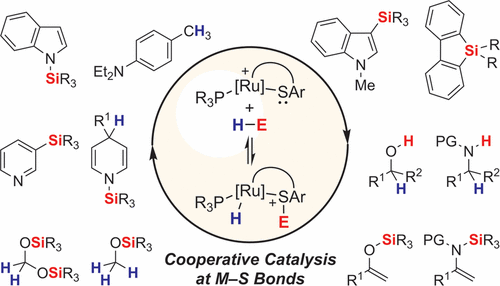当前位置:
X-MOL 学术
›
Acc. Chem. Res.
›
论文详情
Our official English website, www.x-mol.net, welcomes your
feedback! (Note: you will need to create a separate account there.)
Cooperative Catalysis at Metal–Sulfur Bonds
Accounts of Chemical Research ( IF 16.4 ) Pub Date : 2017-04-13 00:00:00 , DOI: 10.1021/acs.accounts.7b00089 Lukas Omann 1 , C. David F. Königs 1 , Hendrik F. T. Klare 1 , Martin Oestreich 1
Accounts of Chemical Research ( IF 16.4 ) Pub Date : 2017-04-13 00:00:00 , DOI: 10.1021/acs.accounts.7b00089 Lukas Omann 1 , C. David F. Königs 1 , Hendrik F. T. Klare 1 , Martin Oestreich 1
Affiliation

|
Cooperative catalysis has attracted tremendous attention in recent years, emerging as a key strategy for the development of novel atom-economic and environmentally more benign catalytic processes. In particular, Noyori-type complexes with metal–nitrogen bonds have been extensively studied and evolved as privileged catalysts in hydrogenation chemistry. In contrast, catalysts containing metal–sulfur bonds as the reactive site are out of the ordinary, despite their abundance in living systems, where they are assumed to play a key role in biologically relevant processes. For instance, the heterolysis of dihydrogen catalyzed by [NiFe] hydrogenase is likely to proceed through cooperative H–H bond splitting at a polar nickel–sulfur bond.
中文翻译:

金属-硫键的协同催化
近年来,合作催化已经引起了极大的关注,已成为开发新型原子经济和对环境更有益的催化过程的关键策略。特别是,具有金属-氮键的Noyori型配合物已被广泛研究,并发展成为氢化化学中的优先催化剂。相比之下,含有金属-硫键作为反应位点的催化剂,尽管它们在生物系统中含量丰富,但在生物系统中起着关键作用,却与众不同。例如,[NiFe]氢化酶催化的二氢杂化可能通过在极性镍-硫键上进行的H-H键断裂而进行。
更新日期:2017-04-13
中文翻译:

金属-硫键的协同催化
近年来,合作催化已经引起了极大的关注,已成为开发新型原子经济和对环境更有益的催化过程的关键策略。特别是,具有金属-氮键的Noyori型配合物已被广泛研究,并发展成为氢化化学中的优先催化剂。相比之下,含有金属-硫键作为反应位点的催化剂,尽管它们在生物系统中含量丰富,但在生物系统中起着关键作用,却与众不同。例如,[NiFe]氢化酶催化的二氢杂化可能通过在极性镍-硫键上进行的H-H键断裂而进行。











































 京公网安备 11010802027423号
京公网安备 11010802027423号